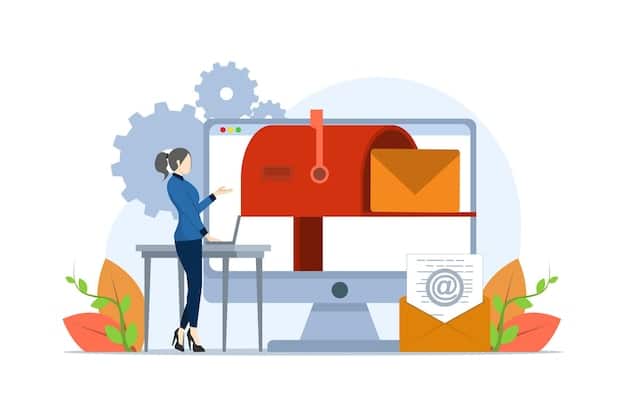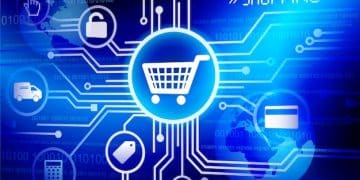Boost E-commerce Sales in 2025: Email Automation Guide

E-commerce Email Automation: Setting Up Effective Campaigns That Generate Sales in 2025 involves strategically using automated emails to engage customers, personalize experiences, and drive conversions. By mastering segmentation, crafting compelling content, and optimizing send times, e-commerce businesses can significantly enhance their marketing efforts and achieve substantial sales growth.
Are you ready to transform your e-commerce business and skyrocket sales? In the fast-paced digital landscape of 2025, e-commerce email automation: setting up effective campaigns that generate sales in 2025 is no longer a luxury but a necessity. It’s about working smarter, not harder, by leveraging technology to nurture customer relationships and boost revenue.
This comprehensive guide will walk you through the essential strategies and tactics to create email automation campaigns that resonate with your audience, drive engagement, and, most importantly, generate sales. Let’s dive in and unlock the immense potential of email automation for your e-commerce success.
Understanding E-commerce Email Automation: The 2025 Landscape
E-commerce email automation is the process of using software to send automated emails to customers based on specific triggers and behaviors. In 2025, this technology has become more sophisticated than ever, with advanced personalization, enhanced segmentation, and AI-powered optimization.
Let’s explore what this looks like in practice.
The Evolution of Email Marketing
Email marketing has come a long way. The days of mass, generic email blasts are over. Today, customers expect personalized, relevant content that adds value to their lives. That’s where e-commerce email automation: setting up effective campaigns that generate sales in 2025 shines. It allows you to deliver the right message to the right person at the right time, fostering deeper connections and driving conversions.
Key Benefits of Automation
Implementing email automation can bring a wealth of benefits to your e-commerce business. Let’s highlight a few pivotal advantages:
- Improved Customer Engagement: Automated emails, tailored to individual customer behaviors and preferences, keep your audience engaged and coming back for more.
- Increased Sales: Nurturing leads with relevant content and timely offers can significantly boost your sales figures.
- Time Savings: Free up your team’s time by automating repetitive tasks, such as sending welcome emails or abandoned cart reminders.
- Personalized Customer Experience: Deliver personalized content that resonates with each customer, fostering loyalty and advocacy.
In essence, email automation is a cornerstone of modern e-commerce. It empowers businesses to connect with customers on a deeper level, streamline their marketing efforts, and drive sustainable sales growth.

Setting Up Your First Automated Campaign
Creating an automated email campaign may seem daunting, but breaking it down into manageable steps makes it achievable. Here’s a step-by-step guide to getting started.
We will explore how to implement e-commerce email automation: setting up effective campaigns that generate sales in 2025.
Defining Your Goals
Before diving into the specifics of campaign setup, it’s crucial to define your goals. Ask yourself: What do you want to achieve with this campaign? Are you looking to increase sales, generate leads, or improve customer engagement? Having clear objectives will guide your strategy and help you measure success. For example, you might aim for a 15% increase in sales within the first quarter through implementing email automation.
Choosing the Right Automation Platform
Selecting the right email automation platform is essential. Popular options include Mailchimp, Klaviyo, and ActiveCampaign. Evaluate each platform based on your needs and budget. Consider factors such as:
- Ease of Use: Can you easily navigate the platform and create campaigns without extensive training?
- Segmentation Capabilities: Does the platform offer robust segmentation options to target specific customer groups?
- Integration with Your Tech Stack: Does it seamlessly integrate with your e-commerce platform, CRM, and other marketing tools?
- Pricing: Does the pricing align with your budget and the size of your email list?
Prioritize a platform that not only meets your current needs but also scales with your business as you implement e-commerce email automation: setting up effective campaigns that generate sales in 2025.
Crafting Compelling Email Content
The content of your automated emails is a crucial factor in determining their success. Generic, uninspired content will quickly be ignored. Compelling content, on the other hand, captures attention, builds trust, and drives action.
Let’s discuss content that resonates with customers in the new era of e-commerce email automation: setting up effective campaigns that generate sales in 2025.
Personalization is Key
In 2025, personalization is non-negotiable. Customers expect emails that are tailored to their individual preferences and behaviors.
Writing Engaging Subject Lines
Your subject line is the first (and sometimes only) opportunity to capture your audience’s attention. Here are some tips for crafting compelling subject lines:
- Keep it Short and Sweet: Aim for a subject line that is concise and easy to understand.
- Create a Sense of Urgency: Use words like “Limited Time,” “Last Chance,” or “Exclusive” to encourage immediate action.
- Personalize the Subject Line: Include the recipient’s name or mention a recent purchase or browsing behavior.
- Make it Relevant: Ensure the subject line accurately reflects the content of the email.
Successful email marketing in 2025 hinges on delivering value, building trust, and creating personalized experiences that resonate with each individual recipient. Crafting compelling content is essential for achieving these goals and seeing tangible results.

Leveraging Segmentation for Maximum Impact
Segmentation is the process of dividing your email list into smaller, more targeted groups based on specific criteria. By segmenting your list, you can send more relevant emails that resonate with each group’s unique needs and interests.
Effectiveness in the era of e-commerce email automation: setting up effective campaigns that generate sales in 2025 largely depends on customer data.
Behavior-Based Segmentation
Segmenting your list based on customer behavior can be highly effective. Examples of behavior-based segments include:
Past purchase data assists in e-commerce email automation: setting up effective campaigns that generate sales in 2025 efforts.
- Recent Purchasers: Target customers who have recently made a purchase with a thank-you email, a request for a review, or a special offer for their next purchase.
- Frequent Buyers: Reward loyal customers with exclusive discounts or early access to new products.
- Inactive Customers: Re-engage customers who haven’t made a purchase in a while with a win-back campaign.
- Abandoned Cart Users: Send automated reminders to customers who have left items in their cart without completing the purchase.
Demographic Segmentation
Demographic segmentation involves dividing your list based on demographic data such as age, gender, location, and income. This can be useful for tailoring your messaging to specific groups.
Analyzing and Optimizing Your Campaigns
Once your automated campaigns are up and running, it’s essential to track their performance and make adjustments as needed. Data provides clarity and insight into the success of e-commerce email automation: setting up effective campaigns that generate sales in 2025 efforts.
Let’s discuss methods of optimization.
Tracking Key Metrics
Pay attention to key metrics such as open rates, click-through rates, conversion rates, and unsubscribe rates. These metrics provide valuable insights into the effectiveness of your campaigns.
A/B Testing
A/B testing involves creating multiple versions of an email and sending them to a small subset of your audience. By tracking the performance of each version, you can identify the elements that resonate most with your audience. This helps your efforts at e-commerce email automation: setting up effective campaigns that generate sales in 2025 efforts, too.
Continuous Improvement
Email automation is not a “set it and forget it” strategy. Continuous improvement is key to maximizing the effectiveness of your campaigns. Regularly analyze your results, identify areas for improvement, and make adjustments as needed. By staying agile and data-driven, you can ensure that your email automation efforts continue to drive sales and engagement in 2025 and beyond.
Staying Ahead: Trends in Email Automation for 2025
As we move towards 2025, several trends are shaping the future of email automation. Staying ahead of these trends is crucial for maintaining a competitive edge.
Staying relevant is key for e-commerce email automation: setting up effective campaigns that generate sales in 2025.
AI-Powered Personalization
Artificial intelligence is playing an increasingly important role in email automation. AI algorithms can analyze vast amounts of data to deliver hyper-personalized experiences that resonate with individual customers. We can ensure that our e-commerce email automation: setting up effective campaigns that generate sales in 2025 efforts rely on AI.
Mobile Optimization
With the majority of emails being opened on mobile devices, mobile optimization is more important than ever. Ensure that your emails are responsive and display correctly on all screen sizes. Optimize images, font sizes, and button placement for mobile users.
Enhanced Security
Data privacy and security are top concerns for consumers. Ensure that your email automation platform adheres to the latest data privacy regulations, such as GDPR and CCPA. Be transparent about how you collect and use customer data.
| Key Point | Brief Description |
|---|---|
| 🚀 Automation Setup | Efficiently configure email automation for targeted campaigns. |
| 🎯 Content Creation | Craft compelling, personalized content for higher engagement. |
| 📊 Segmentation | Leverage segmentation to target specific customer groups. |
| 📈 Analysis & Optimization | Analyze campaign performance and optimize for better results. |
Frequently Asked Questions
E-commerce Email Automation: Setting Up Effective Campaigns That Generate Sales in 2025 involves using software to send targeted, automated emails based on customer actions. It boosts engagement, saves time, and increases sales through personalized experiences.
Consider factors like ease of use, segmentation capabilities, integration with your existing tech stack, and pricing. Popular options include Mailchimp, Klaviyo, and ActiveCampaign, so evaluate which best fits your needs and budget.
Compelling content involves personalization, concise subject lines, relevant offers, and a clear call to action. Tailoring your message to resonate with each customer’s unique preferences is crucial for driving action.
Segmentation allows you to divide your email list into targeted groups based on behaviors and demographics. By sending more relevant emails, you increase engagement, conversions, and overall customer satisfaction.
Stay updated on trends like AI-powered personalization, greater mobile optimization, and better data security to enhance E-commerce Email Automation: Setting Up Effective Campaigns That Generate Sales in 2025. These trends help you deliver better customer experiences.
Conclusion
Embracing e-commerce email automation: setting up effective campaigns that generate sales in 2025 unlocks significant potential for increased sales and enhanced customer engagement. By focusing on personalization, segmentation, and continuous optimization, e-commerce businesses can thrive in the competitive digital landscape.
As we look ahead to 2025, staying informed about emerging trends and technologies will be key to maintaining a competitive edge and driving lasting success. Start implementing these strategies today and watch your e-commerce sales soar.





